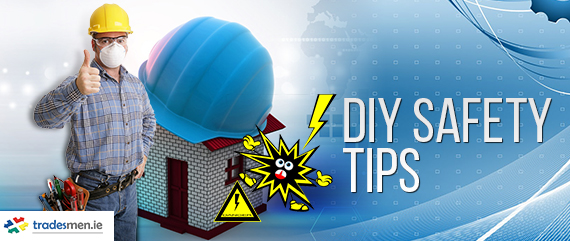this week I want to talk about DIY safety tips in the home. It’s fantastic to try and do some DIY home improvements yourself from time to time. However, DIY can involve the use of power tools, working at heights, working in dusty or mouldy environments, lifting heavy objects etc. and there are certain precautions you need to take in order to keep yourself safe. Here is a list of 9 DIY Safety tips below that will help you when carrying out DIY in the home:-
1. Read the Manual, Read the Label

Read the labels on the products you buy, and pay particular attention to the safety directions. If working with tools, read the manual and again pay particular attention to the safety directions. Some tools are particularly dangerous such as angle grinders, high speed circular saws and chainsaws. In these cases you should consider doing a safety course on their use or hire in a professional who is properly trained in their use.
2. Dress with Safety in Mind
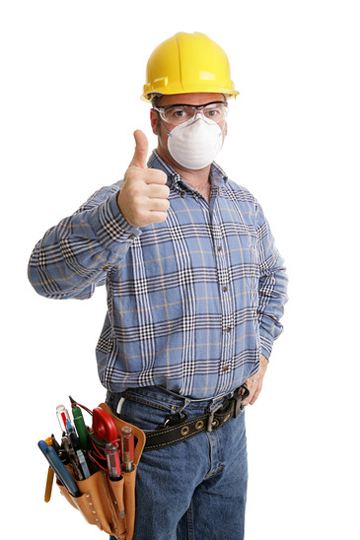
If you are working with anything that spins (like a saw), don’t have jewelry, long hair or long sleeves dangling around that could be caught up and pull you in. Wearing shorts or sandles in an area where there are sharp or hot objects can also cause problems. It’s best to reduce bear skin to a minimum and to wear protective clothing that is appropriate for the task. The most common types of safety clothing include helmet, gloves, goggles, ear muffs, breathing mask, overalls, apron and boots. You may need some or all of these depending on the type of job you are undertaking.
3. Be Careful with Electricity
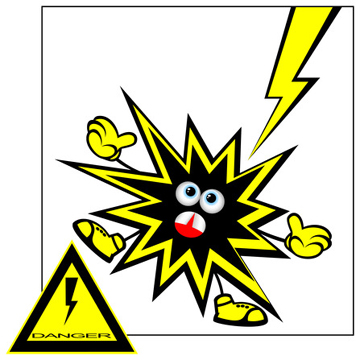
a) For electrical repairs and maintenance only use a registered electrician. Ask for their RECI or ECSSA identification before you allow them to work in your home.
b) Don’t overload sockets. You may be able to use more than one low powered devices on one socket such as a mobile phone charger or laptop charger but high powered electric tools use a lot of power and are not meant to share one socket together. Surprisingly, an electric kettle can use as much or more power than many power tools and electrical appliances. Check with an electrician if you are unsure.
c) Check that your home appliances are protected with residual current devices which shut off power and prevent shocks. Again, if in doubt ask an electrician.
d) Keep an eye on the condition of the plugs and sockets. If you find any burnt or frayed wires get an electrician to fix them.
e) Never ever allow electric wires or cables to trail over moving objects such as saw blades or kitchen appliances like toasters or stove tops.
f) Be careful about putting nails or screws in the walls of your home as there may be wires behind the wall. In addition to this take care when digging or excavating below ground as you run the risk of cutting live underground wire. You can buy equipment for detecting wires. Alternatively, hire a tradesman who has this equipment already.
g) Don’t mix liquids and electricity. They should be kept as far apart as possible. Make sure your hands are try when you handle your power tools and kitchen appliances.
h) Be very careful about taking power tools into the bathroom. Anywhere there is water is extremely dangerous for electrically powered tools and appliances.
4. Working at Heights
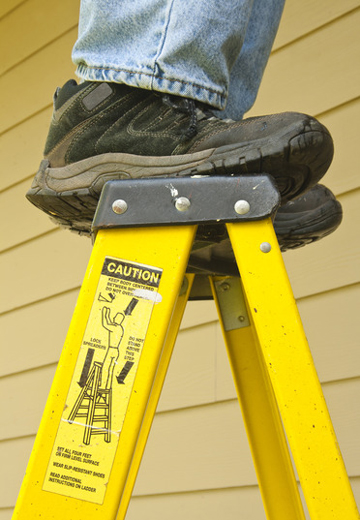 If you have a roof repair in mind, call a professional roofer. If you are adament you want to go up there yourself then buy a safety harness and make sure you have it put on correctly.
If you have a roof repair in mind, call a professional roofer. If you are adament you want to go up there yourself then buy a safety harness and make sure you have it put on correctly.
Even working at lower heights can be dangerous. When using a ladder, keep reminding yourself that heights are dangerous, and be observant at all times.
a) Put ladders on stable, level surfaces.
b) Lock A-frame ladders in the open position as recommended by the manufacturer.
c) Do not step on the top two rungs of a ladder.
d) Lean ladders against the vertical surfaces with an adequate spread at the bottom. Anchor the bottom of the ladder to prevent it from moving.
e) Don’t use aluminum or steel ladders near electric poles or around electrical wires.
f) Do not place a ladder in front of a door that swings out unless the door has been locked.
g) Wear a safety helmet and use a harness if necessary
5. Tips for Lifting
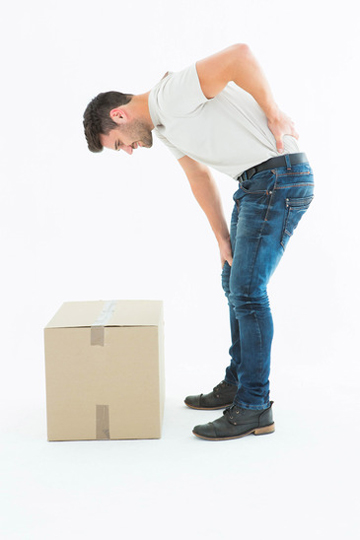 It’s easy to pull a muscle or put out a disk if you’re not careful. Follow these tips to avoid doing harm to your back when lifting:
It’s easy to pull a muscle or put out a disk if you’re not careful. Follow these tips to avoid doing harm to your back when lifting:
a) Your feet should be shoulder-width apart, with one foot slightly ahead of the other.
b) Squat down, keep your back straight, bend at the hips and knees only. If needed, put one knee on the floor and your other knee in front of you, bent at a right angle (half kneeling).
c) Look straight ahead, keep your back straight, your chest out, and your shoulders back. This helps keep your upper back straight while having a slight arch in your lower back.
d) Slowly lift by straightening your hips and knees. Keep your back straight, and don’t twist as you lift.
e) Hold the load as close to your body as possible, at the level of your belly button.
f) Use your feet to change direction, taking small steps.
g) Lead with your hips as you change direction. Keep your shoulders in line with your hips as you move.
h) Set down your load carefully, squatting with the knees and hips only and remembering to keep your back straight.
i) If the object is too heavy do not attempt to lift on your own, get someone to give you a hand or get a machine to lift it.
j) Wear steal toe cap boots if there is a danger of a heavy object falling on your toe.
6. Chemicals and Harzardous liquids
This can apply to chemicals used in the garden or the home. Chemicals used in the garden would typically be herbicides and pesticides.
Chemicals used in the home could be cleaning products, paints and preservatives etc.
a) Always read the label before you start. Take any necessary precautions and wear protective clothing as recommended by the manufacturer. For herbicides and pesticides you should be covered from head to toe, you don’t want any of those chemicals getting on any part of your body.
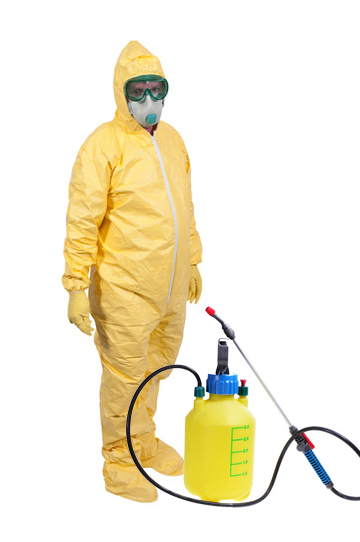
b) If spraying chemicals outdoors never spray chemicals in wet or windy conditions. Wind can carry the chemical and may lead to the chemical being blown on to your children or your neighbours or back into your path.
c) The same goes for rain, never spray outdoors in wet weather. Rain will wash the chemical off the plants and into waterways.
d) It is safer to use a ready mixed solution where possible. These don’t need mixing so exposure to concentrated chemical can be avoided.
e) Do not go over the concentration mix recommended.
f) Lock chemicals away so that animals or children cannot get at them.
g) Allow amount of time (as recommended by the manufacturer) for chemicals to absorb before allowing adults, animals or children back into the area.
h) Chemicals should be stored in their original containers. Never put chemicals in food or drink containers.
i) Dispose of chemicals once opened after the recommended amount of time as specified by the manufacturer.
j) Chemical containers should be rinsed thoroughly and allow to drain in a safe place before being disposed off at your Local Authority civic amenity centre. To find out what materials are accepted at your nearest facilities please contact your local authority or visit their website.
7. Mould and Dust
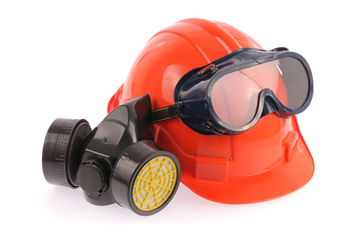 Working with dust and mould in particular can cause skin and respiratory problems if you are unprotected. Make sure to wear proper protective gloves and overalls to stop dust and spores from landing on your skin. Be sure to get a good quality dust mask and goggles. Cheaper products will not protect you adequately. Ask for advice where you buy the protective gear to ensure you are fully protected.
Working with dust and mould in particular can cause skin and respiratory problems if you are unprotected. Make sure to wear proper protective gloves and overalls to stop dust and spores from landing on your skin. Be sure to get a good quality dust mask and goggles. Cheaper products will not protect you adequately. Ask for advice where you buy the protective gear to ensure you are fully protected.
8. Flying Particles and Radiation
It is important to protect your eyes when working with saws, angle grinders or any situation where chips, sparks or particles can fly and strike you in the eye. Make sure to buy a good quality goggles that completely enclose and protect the eye area and prevent anything from hitting the eyes from the front or from the side.
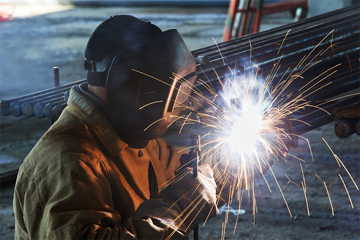 If welding you will need to protect your eyes from glare, radiation and flying sparks. For this you need a special type of mask that will completely block out harmful radiation that could cause serious eye problems and blindness if left unprotected. Good quality overalls, gloves and an apron will also help protect you and the clothes you are wearing from getting burnt from flying sparks.
If welding you will need to protect your eyes from glare, radiation and flying sparks. For this you need a special type of mask that will completely block out harmful radiation that could cause serious eye problems and blindness if left unprotected. Good quality overalls, gloves and an apron will also help protect you and the clothes you are wearing from getting burnt from flying sparks.
9. Fire Prevention
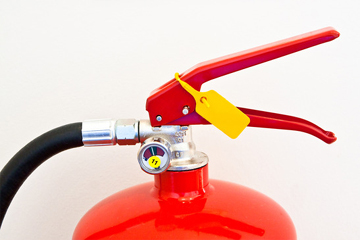 Fires can be caused when by sparks flying from grinders or saws, from combustion engines or electrical equipment. Fires can also be caused by torches or flammable liquids so make sure to have a fire extinguisher and a fire blanket near your DIY workbench and also in the kitchen. Remember that a water fire extinguisher can’t be used on electrical appliances. Powder extinguishers will cover Class A, B & C fire risks but can damage goods and machinery if used indoors. Co2 is good for fires involving electrical equipment but does not give post fire security (i.e. the fire good re-ignite). So be sure to seek expert advice when choosing a fire extinguisher and familiarise yourself and your family with what it can and cannot be used for every few months as it is easy to forget.
Fires can be caused when by sparks flying from grinders or saws, from combustion engines or electrical equipment. Fires can also be caused by torches or flammable liquids so make sure to have a fire extinguisher and a fire blanket near your DIY workbench and also in the kitchen. Remember that a water fire extinguisher can’t be used on electrical appliances. Powder extinguishers will cover Class A, B & C fire risks but can damage goods and machinery if used indoors. Co2 is good for fires involving electrical equipment but does not give post fire security (i.e. the fire good re-ignite). So be sure to seek expert advice when choosing a fire extinguisher and familiarise yourself and your family with what it can and cannot be used for every few months as it is easy to forget.
As you can see a lot of these precautions are just common sense but by using them you will help prevent accidents happening to you or your family. If you find that it’s more hassle than it’s worth then be sure to post a job on Tradesmen.ie and get up to 4 quotes for your job from Rated Tradesmen🙂
Cheers
Oliver Dempsey
Tradesmen.ie
18th April 2015
Here are some other articles that you might be interested in below:-
Electric Gates – Options and Prices
Water Charges – Conserving Water in the Home and Garden
Home Improvement Tips that Add Value to your Home
Tips for Removing Common Stains in the Home
Tips for Reducing your Heating Bill
Home Improvement Tips for Wet Weather

